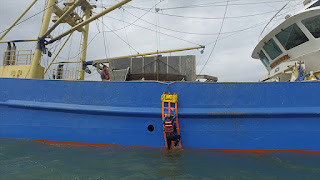 |
AIBDC : 008605 Image credit: MoDiP |
This bright and sunny, yellow coloured frisbee is in an amazing condition given that it is over 70 years old. That is largely due to the fact that it has been unused: 1600 of these Arcuate Vanes were discovered in a warehouse in 1977, where this example is believed to have originated. We think it was injection moulded in butyl stearate.
 |
Fred
Morrison’s design for the Whirlo Way. Image credit: https://www.flyingdiscmuseum.com/ antiques/flyinsaucers/hAFB25767#hb0fc7f78 |
It was designed by Fred Morrison who had been inspired to create a new toy by watching children throwing empty pie tins to each other. According to Phil Kennedy at the Flying Disc Museum, Morrison created his first flying disc in 1946 out of metal with a wire frame for additional weight and strength, called the Whirlo Way (refer image above). This became the basis of his design for a plastics version two years later called the Flyin-Saucer (refer image below), capitalising on the American UFO craze of that time. It was moulded by the Southern California Plastic Company (SCP) for Pipco, a business set up by Morrison and his friend Warren Franscioni who had met as pilots during WWII.
 |
The
first version of Pipco’s Flyin-Saucer, released between 1948-1950. |
By 1949, Pipco were marketing the toy as a gyroscopic airfoil, sold wrapped with a paper insert that described how to use it and how to order more. The following year they released their second design (MoDiP’s example), which they called the L'il Abner's Flyin-Saucer, packaged with a sticker on the top face and a round card insert featuring the popular satirical comic strip drawn by Alfred Caplin/Al Capp (refer image below).
 |
The sticker
and card insert. Image credit: MoDiP |
 |
| Fred Morrison promoting
his Pluto Platter, 1957. Image credit: https://www.theguardian.com/theguardian/2010/apr/29/fred-morrison-obituary |
Collections Officer
























